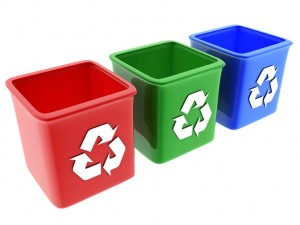- 1 read

You want to be green, but it's hard to know the difference between reusing and recycling. Fortunately, it's not that complicated. Recycling and reusing have the same goal: to keep items out of overflowing landfills. The two tactics just go about it in very different ways.
Recycling involves reprocessing an old item -- such as a can, glass or newspaper -- and turning it into something new. Recycled paper products may be reprocessed into toilet paper and old tires may become a compound used to resurface roads.
Reusing, on the other hand, means avoiding the reprocessing plant altogether. Old items like containers, bags and appliances can be used again in their current condition for a similar -- or completely different -- purpose. Takeout containers can be turned into food storage (think: free plastic containers!), and plastic bags can be transformed into waterproof liners for planters or drawers.
"Reusing extends the lifetime of a product, from the time it is purchased to the time it goes to a landfill [or recycling plant]," explains Janine Kubert, director of operations at iReuse, a company that helps businesses and individuals become better reusers.
When you extend the lifetime of a product, you not only reduce the need to buy something new (which takes energy to produce), but you also save on the energy it would take to recycle that product. "Reusing allows us to get the most out of our virgin products and raw materials, and aside from reducing consumption entirely, it is our best resource for waste reduction," says Kubert.
Whether you're an avid recycler or new to waste reduction, here are some simple ways to reuse and recycle every day:
Reuse
- Reuse bags, boxes and containers. For example, turn old shoe boxes into storage containers, packaging for gifts or a treasure chest (have kids cut out pictures from magazines and glue them to the outside of the box for a customized container).
- Rather than buying a new product, borrow, rent or share items you use infrequently or for a short period of time.
- When babies and kids outgrow toys, books, cribs, high chairs and strollers, sell or donate the items rather than throw them away.
- Invest in quality, durable products. You may spend more initially, but they'll last longer, which saves you money over time.
Recycle
- Become a full-circle recycler. Buy products that can be recycled; sort and discard them according to your community's standards; and finally, purchase products made from post-recycled materials.
- For more information about recyclable materials, check out the EPA's website.
Going Above and Beyond
While waste reduction starts at home, communities nationwide are forming around the premise that less is more. Freecycle -- started in Tucson, Ariz., before spreading throughout the U.S. -- helps people be the best possible reusers. Through the Freecycle network, members are able to donate -- or pick up -- used products, such as appliances, furniture, toys and bikes.
In need of a reduce, reuse and recycle tutorial? Companies like iReuse give personalized consultations to help you reduce waste, donate reusable products and save money.
If you're not sure about your community's procedures or standards for reusing and recycling, check your town's government Web site or ask a neighbor. Through community boards, donation banks and home and school recycling programs, it's getting even easier to do more to waste less.
Dana Goeglein received a bachelor's in creative writing from Sarah Lawrence College and a master's in food studies from New York University. She is a writer, yoga instructor and whole foods educator in New York City, where she strives to help others create harmonious, connected lives.
This independant editorial content is brought to you by: Managing Editor Marisa Belger

